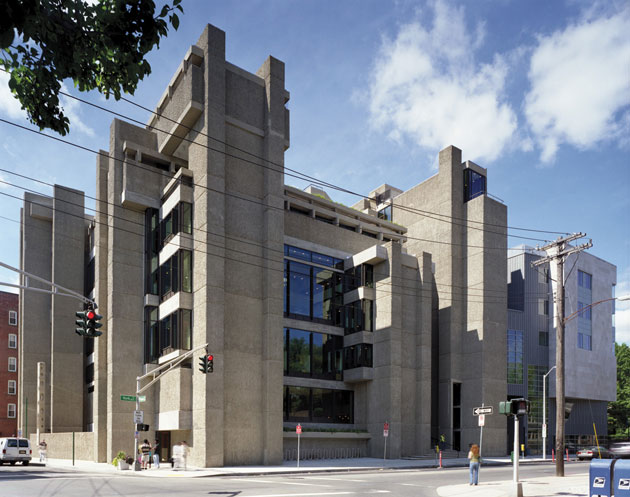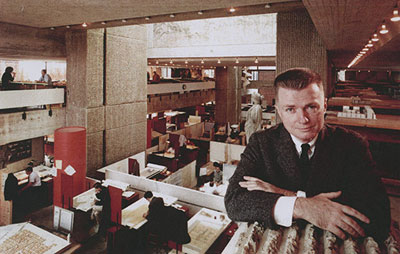|
|
||
|
Gillian Darley welcomes a re-evaluation of a hugely influential but flawed architect, whose fall was as spectacular as his rise The architectural monograph can be pedestrian, albeit dusted with a light icing of glamour. Not this one. Timothy M Rohan gives a brilliant account of the apocalyptic arc of Paul Rudolph’s career. His stellar trajectory, from the Alabama Polytechnic Institute to the chairmanship of the Department of Architecture at Yale in less than 20 years, is set against his descent in a cloud of hubris, fire and criticism, to designing flatulent developments in south-east Asia. For all that, Rudolph’s mark on mid-20th century architecture was profound. A Methodist minister’s son, like Frank Lloyd Wright, he admired the latter’s ability to graft romanticism and individualism on to modernism. In Sarasota, Florida, Rudolph gained invaluable experience alongside a local architect, Ralph Twitchell.
Timothy M Rohan’s book At Harvard’s Graduate School of Design he was a favoured student of Walter Gropius. Due to the war, he attended just two semesters, in 1941 and 1946, but remained strategic to his fingertips. While travelling in Europe in the late 1940s, he continued working, designing modernist houses in “warm weather regionalism”, such as the Healy Guest House in Sarasota, the catenary slung roof of which was intended to defy hurricanes (it didn’t). Typically, his ideas galloped ahead of practicality. In 1952 his break with Twitchell, to whom he owed much, was peculiarly vituperative. Rudolph’s annus mirabilis came in 1954. At the American Institute of Architects meeting in Boston he spoke alongside Eero Saarinen and Josep Lluís Sert and, as Rohan writes, while saying little new, “articulated the anxieties and hopes of the discipline in an energetic, optimistic way”. His speech was widely published, for he had already received a major commission – the US Embassy in Jordan, where he again showed his cavalier approach to practicalities, including safety and security. In 1958 the project was shelved, but by then he had secured the Jewett Arts Center at Wellesley College in Massachusetts.
Rudolph in the A&A Building, now Rudolph Hall, at Yale University in Connecticut By now, Rudolph was the man of the moment. He was in great demand as a teacher (at Yale, Harvard and MIT), his draughtsmanship was fine, if idiosyncratic, and he styled his jobs for publication with flair. In 1958, still in his thirties, he became chairman of Yale University Department of Architecture, having been the favoured candidate of the university president, A. Whitney Griswold, and his adviser, the architectural historian Vincent Scully. Next came the commission for the Architecture and Art (A&A) building itself. Overseas masters students, such as Norman Foster and Richard Rogers, and visiting critics – Robert Venturi among them – flocked to Yale. Rudolph’s regime was proving magnetic. But Rudolph’s challenge to the international style came with risks, both academic and technical. He claimed to avoid theory yet took Geoffrey Scott’s The Architecture of Humanism as his guide. For the Blue Cross and Blue Shield building in Boston he fed heating and cooling through the external frame, freeing up the interiors. But his structural rationalism was more symbolic than practical. By the 1970s he was involved in at least seven construction lawsuits.
Rudolph at the Sanderling Beach Club in Florida, which he designed in 1952 It was the A&A building that exposed Rudolph. What was romantic modernism, people wondered? Temple Street parking garage in New Haven (1958-63) – the inspiration for Preston bus station – bore little relationship to the Jewett or the BC & BS tower. Was Rudolph a genius or a charlatan? For Peter Collins and Reyner Banham he was a reactionary, no new brutalist, tainted by his association with Philip Johnson and “ballet architecture”. Rudolph undermined himself with windy justifications (“An age expresses through its artist certain preferences and attitudes … but no man can ascertain at the time those which have validity”) and endemic indecision. The A&A building was dedicated in November 1963 (after Griswold’s death) and a highly critical keynote address given by Nikolaus Pevsner. In June 1969 the building was gutted by fire. It took almost 40 years for it to be reconfigured successfully, by Charles Gwathmey. It has taken even longer for Rudolph’s contribution to 20th-century architecture – including huge publicly funded commissions such as the Boston Government Service Centre, as well as his work on prefabrication and megastructures – to be evaluated. Rohan’s book, frank, fair and intuitive, sets the record straight. |
Words Gillian Darley
Above: Rudolph Hall in New Haven, Connecticut
The Architecture of Paul Rudolph |
|
|
||





















